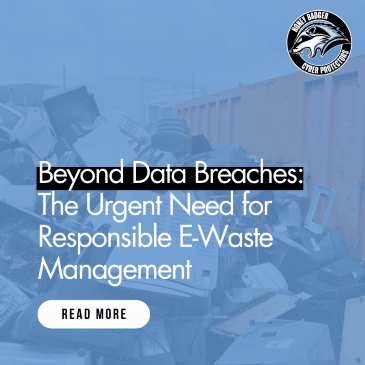Beyond Data Breaches: The Urgent Need for Responsible E-Waste Management
 In today’s world, we depend heavily on electronic devices, from smartphones and laptops to household appliances. However, what happens when these devices reach the end of their useful lives? The answer lies in the often-overlooked issue of electronic waste, or e-waste.
In today’s world, we depend heavily on electronic devices, from smartphones and laptops to household appliances. However, what happens when these devices reach the end of their useful lives? The answer lies in the often-overlooked issue of electronic waste, or e-waste.
This month, as we celebrated Earth Month and the beauty of our planet and reflected on our impact on the environment, we should also continually shine a light on the staggering reality of global e-waste accumulation. According to the United Nations Global E-waste Monitor, released just last year, the world generated a staggering 62 million metric tons of e-waste in 2022 alone. To put that into perspective, this waste could fill more than 1.5 million 40-metric-ton trucks, forming a line long enough to wrap around the equator.
E-waste includes any discarded product that has a plug or a battery, often containing toxic and hazardous substances such as mercury and lead. As the demand for electronics continues to soar, particularly in developing countries, this hazardous waste stream is booming. However, the alarming truth is that our capacity to recycle e-waste is not keeping pace with its exponential growth. If a company or individual uses technology, they have a responsibility to dispose of it properly.
Sadly, less than a quarter of e-waste produced in 2022 was documented as collected and recycled, according to the UN report. The consequences of this shortfall are dire: most e-waste ends up in landfills or informal recycling systems, posing significant risks to both human health and the environment. Despite efforts to promote recycling, small electronic gadgets like toys and vacuum cleaners have alarmingly low recycling rates, hovering around 12%.
As the gap between e-waste generation and recycling capacity continues to widen, the repercussions are far-reaching. Not only does e-waste contribute to environmental pollution, but it also exacerbates climate change. Electronic devices require raw materials, including rare earth metals, extracted and processed through energy-intensive methods powered mainly by fossil fuels. Proper e-waste management and disposal not only reduce pollution but also cut down global carbon emissions by reclaiming metals and reducing the need for new raw materials.
However, the responsibility for addressing the e-waste crisis does not rest solely on consumers. Manufacturers and corporate users must take accountability for the lifecycle of their products, designing them with durability and recyclability in mind and committing to processes for proper destruction (ITAD). Clear plans for the removal, collection, and recycling of toxic components are essential to mitigating the environmental and health impacts of e-waste.
Furthermore, international cooperation and policy intervention are critical to addressing the e-waste challenge effectively. While some countries have implemented e-waste regulations, enforcement remains a significant challenge globally. Wealthy nations must cease the practice of dumping e-waste in countries ill-equipped to handle it, prioritizing investment in infrastructure development and capacity building.
As we strive for a more sustainable future, the management of e-waste demands urgent attention. This month and always, we join you in our commitment to responsible consumption and conscientious disposal of electronic products. Together, we can make a meaningful difference in preserving our planet for generations to come.
Wei, H., Wang, X., & Yang, T. (2024). A Dual-Channel Cooperative Strategy between Recyclers and E-Tailers for the Offline and Online Recycling of Waste Electronics. Sustainability, 16(4), 1443.








